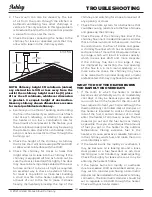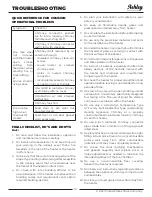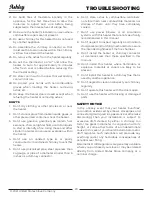
6
© 2021 United States Stove Company
1” min
Airspace
Mantel Heat Shield
(min 24-gauge
sheet metal)
Combustible
Mantle
5/8” Thick Fireclay or
Stainless Steel Liner
Extend
Connect
or Into
Liner
Damper
Plate Is
Removed
Or Fastened
In Open
Position
Use
Damper
Adaptor Or
Seal With
Sheetmetal
And
Sealant
Sealed Fireplace Chamber
Cover Plate (Non-combustible)
FACTORY BUILT CHIMNEY
Listed Cap
Maintain 2”
Clearance
Listed
Chimney
Ceiling
Support
Ceiling
Support
Chimney
Connector
*
* Refer to Clearance
to Combustibles
Combustible Wall
Floor
Protector
To Stove
Storm Collar
Flashing
Listed
Chimney
Attic
Insulation
Sheild
Specified
Clearance
Chimney
Connector
Combustible
Ceiling Joists
To Stove
When a metal prefabricated chimney is used, the
manufacturer’s installation instructions must be
followed. You must also purchase (from the same
manufacturer) and install the ceiling support
package or wall pass-through and “T” section
package, firestops (where needed), insulation
shield, roof flashing, chimney cap, etc. Maintain
proper clearance to the structure as recommended
by the manufacturer. The chimney must be the
required height above the roof or other obstructions
for safety and proper draft operation.
CHIMNEY CONNECTOR AND CHIMNEYS
It is very important to assure safe and satisfactory
performance from your heater that it be properly
connected to a correctly constructed and
maintained chimney. If a Listed High Temperature
Type HT Factory-Built Residential and Building
Heating Appliance Chimney is used, follow the
chimney manufacturer’s installation instructions
carefully. If a masonry chimney is to be used,
be sure it is constructed to the National Fire
Protection Association (N.F.P.A) and local code
standards. The Chimney connector (pipe from
heater to chimney) must be 6” in diameter and
made from 24 gauge or heavier steel. The length
of the chimney connector and number of elbows*
used should be kept to a minimum. Moisture that
might collect in the chimney should be directed to
the heater by providing a slope of 1/4 inch per foot
in a horizontal run of the chimney connector and
installing all pipes with the crimped end toward
the heater. The chimney connector should extend
at least two inches into the flue of a factory-built
chimney. When making a horizontal connection to
a masonry chimney, the connector should extend
to the inside face of the vertical flue liner. When
connecting the heater to a masonry fireplace,
the chimney connector should extend into the
chimney’s liner as shown by the side section view.
All chimney connector joints should be sealed
with furnace cement and secured with #8 sheet
metal screws as described by the TO SAFELY AND
PROPERLY INSTALL THIS HEATER section of this
manual. *Use Corrugated Elbows. DO NO USE
MORE THAN TWO 90 DEGREE ELBOWS IN THE
Chimney CONNECTOR. Installations which require
two degree elbows must be vented into a flue of at
least 8” diameter or 8” square to prevent chimney
draft restrictions. DO NOT PASS A CHIMNEY
CONNECTOR THROUGH A FLOOR OR CEILING OF
INSTALLATION







































